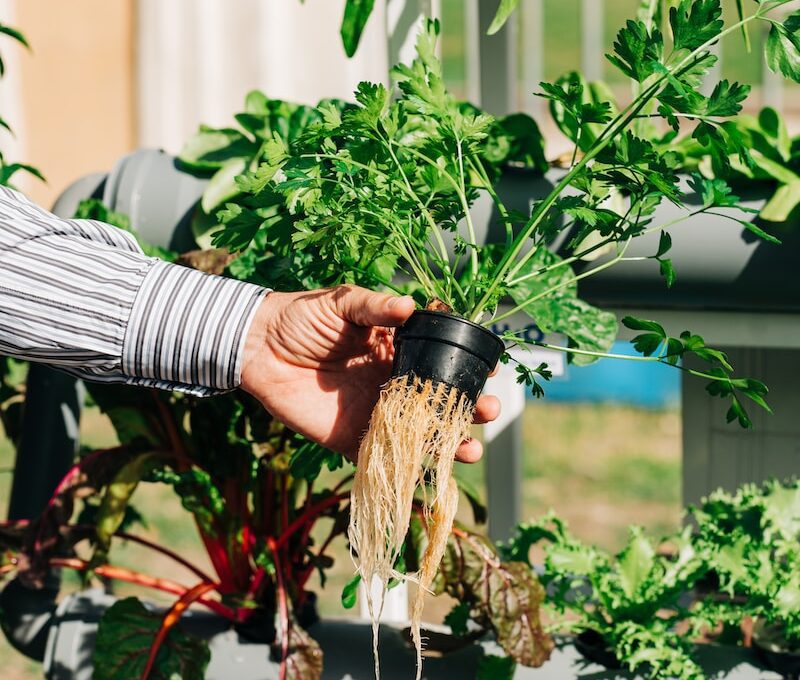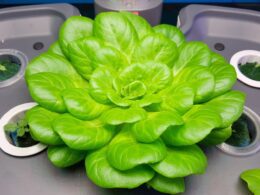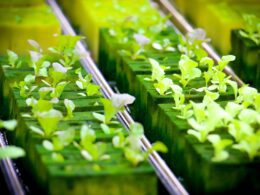Are you wondering whether to grow your lettuce in soil or hydroponics? Both methods have their pros and cons, and it ultimately depends on your preferences and needs.
Soil-grown lettuce is the traditional method and is often associated with natural and healthier produce. On the other hand, hydroponics is a modern and efficient way of growing plants that can save water and space.
Before you decide which method to use, it’s essential to know the differences between soil-grown and hydroponic lettuce. Soil-grown lettuce is grown in traditional garden soil, which contains a complex mixture of organic matter, minerals, and microorganisms. In contrast, hydroponic lettuce is grown in a nutrient-rich water solution, without the use of soil.
While both methods have their advantages, the nutrient content of the lettuce can be affected by the growing conditions. In this article, we’ll compare soil-grown and hydroponic lettuce’s nutrient content and give you recommendations on which method to use based on your needs.
Soil-Grown Lettuce
You’ll find yourself enjoying the crisp and juicy flavor of greens grown in nutrient-rich soil. Soil-grown lettuce has been the traditional method of cultivation for centuries. This method involves planting lettuce seeds in soil that’s been enriched with organic matter and nutrients.
The roots of the lettuce absorb nutrients from the soil, including nitrogen, potassium, and phosphorus, which are essential for healthy growth. The soil composition plays a crucial role in the nutrient absorption of the lettuce. The ideal soil for growing lettuce should be loose, well-draining, and rich in organic matter.
A soil that’s too compact or too sandy can affect the growth of the lettuce negatively. Soil-borne diseases and pests can also be a problem when growing lettuce in soil, but proper crop rotation and good soil management practices can help prevent these issues.
Overall, soil-grown lettuce is a great option for those looking for a natural and traditional way to cultivate greens. The nutrient absorption of lettuce in soil is excellent, and the flavor of lettuce grown in soil is often superior to other methods.
So, if you want to enjoy the freshest and tastiest lettuce, consider growing it in nutrient-rich soil.
Hydroponic Lettuce
If you’re looking for a low-maintenance way to grow your greens, hydroponics may be the way to go. Hydroponic lettuce is grown in a nutrient-rich water solution instead of soil. This growing technique allows for precise control of the plant’s environment, resulting in faster growth, higher yields, and better quality lettuce.
There are several growing techniques used in hydroponic lettuce farming, such as deep water culture, nutrient film technique, and drip irrigation. Each technique has its advantages, but all share the benefits of using less water, space, and fertilizer compared to traditional soil-grown crops.
Hydroponic lettuce is also less susceptible to pests and diseases, which eliminates the need for harmful pesticides.
Overall, hydroponics can provide a sustainable and efficient way to grow lettuce. With the control over the plant’s environment, you can ensure that your lettuce is free from harmful chemicals and has the optimal conditions for growth.
So, if you’re looking for a safe and convenient way to grow your greens, give hydroponic lettuce a try.
Is the Taste of Lettuce Affected by Growing Method?
When it comes to hydroponic lettuce flavor compared to soil-grown lettuce, there is a noticeable difference. While hydroponic lettuce tends to have a milder taste, soil-grown lettuce often carries a richer flavor profile. This variation is primarily attributed to the nutrients and minerals absorbed by plants through their roots. So, the growing method does indeed impact the taste of lettuce.
Comparison of Nutrient Content
When it comes to comparing the nutrient content of hydroponic and soil-grown lettuce, there are a few key points to consider. First, you’ll want to look at the vitamins and minerals present in each option.
Additionally, it’s important to consider any potential pesticide and herbicide use in soil-grown lettuce.
Finally, many people also notice differences in taste and texture between the two methods.
Vitamins and Minerals
Get the most out of your greens by understanding the essential vitamins and minerals present in your lettuce.
Lettuce grown in soil contains high levels of Vitamin K, Vitamin A, and folate. Vitamin K is essential for blood clotting and bone health, while Vitamin A promotes healthy vision and skin. Folate is important for cell growth and development, making it a crucial nutrient for pregnant women.
On the other hand, hydroponically grown lettuce contains higher levels of minerals such as iron, magnesium, and calcium. Iron is crucial for oxygen transport in the body, while magnesium is important for muscle and nerve function. Calcium is essential for strong bones and teeth.
Additionally, hydroponic lettuce may also contain higher levels of Vitamin C, an important antioxidant that supports the immune system.
Ultimately, both growing methods provide health benefits and nutrient absorption, but the specific nutrient content may vary.
Pesticide and Herbicide Use
Growing greens requires the use of chemicals, which can range from harmful pesticides to herbicides. When growing lettuce in soil, it’s common to use pesticides and herbicides to protect the plants from pests and weeds.
However, the use of these chemicals can have negative effects on the environment and can even harm the consumers who eat the lettuce. Pesticide regulations have been put in place to ensure that the use of these chemicals is limited and that the lettuce is safe to eat.
On the other hand, hydroponic systems can greatly reduce the need for pesticides and herbicides. Since the plants aren’t grown in soil, they’re less susceptible to pests and weeds. Additionally, hydroponic systems can be set up in a controlled environment, which can help to prevent the spread of pests and diseases.
This means that hydroponic lettuce can be grown with minimal use of chemicals, resulting in a safer and more environmentally friendly product.
Taste and Texture
You’ll be pleasantly surprised at how the taste and texture of hydroponically grown lettuce compare to those grown conventionally in soil. Hydroponic lettuce has a more delicate flavor profile and a crisp, refreshing mouthfeel.
The controlled environment of hydroponics allows for optimal nutrient absorption, resulting in a more consistent and robust taste. In addition, hydroponically grown lettuce has a consistent texture throughout the entire head, unlike soil-grown lettuce which can have a range of textures from tough stems to wilted leaves.
The lack of soil also means that there’s no grit or dirt to clean off, making prep time quicker and easier. Overall, hydroponic lettuce provides a more enjoyable eating experience with its superior flavor and texture.
Do Hydroponic Lettuce and Tomatoes Have Better Taste Compared to Soil-Grown Varieties?
Do hydroponic lettuce and tomatoes have better taste compared to soil-grown varieties? The answer lies within the hydroponic tomatoes’ taste: better than soil?? By eliminating soil and providing a carefully controlled water and nutrient solution, hydroponic systems can enhance the taste of tomatoes, allowing for optimal flavor development. The absence of soil-borne diseases and the ability to fine-tune growing conditions contribute to the superior taste offered by hydroponic tomatoes.
When it comes to comparing the nutrient content of hydroponic and soil-grown lettuce, there are a few key points to consider. First, you’ll want to look at the vitamins and minerals present in each option.
Additionally, it’s important to consider any potential pesticide and herbicide use in soil-grown lettuce.
Finally, many people also notice differences in taste and texture between the two methods.
Vitamins and Minerals
Get the most out of your greens by understanding the essential vitamins and minerals present in your lettuce.
Lettuce grown in soil contains high levels of Vitamin K, Vitamin A, and folate. Vitamin K is essential for blood clotting and bone health, while Vitamin A promotes healthy vision and skin. Folate is important for cell growth and development, making it a crucial nutrient for pregnant women.
On the other hand, hydroponically grown lettuce contains higher levels of minerals such as iron, magnesium, and calcium. Iron is crucial for oxygen transport in the body, while magnesium is important for muscle and nerve function. Calcium is essential for strong bones and teeth.
Additionally, hydroponic lettuce may also contain higher levels of Vitamin C, an important antioxidant that supports the immune system.
Ultimately, both growing methods provide health benefits and nutrient absorption, but the specific nutrient content may vary.
Pesticide and Herbicide Use
Growing greens requires the use of chemicals, which can range from harmful pesticides to herbicides. When growing lettuce in soil, it’s common to use pesticides and herbicides to protect the plants from pests and weeds.
However, the use of these chemicals can have negative effects on the environment and can even harm the consumers who eat the lettuce. Pesticide regulations have been put in place to ensure that the use of these chemicals is limited and that the lettuce is safe to eat.
On the other hand, hydroponic systems can greatly reduce the need for pesticides and herbicides. Since the plants aren’t grown in soil, they’re less susceptible to pests and weeds. Additionally, hydroponic systems can be set up in a controlled environment, which can help to prevent the spread of pests and diseases.
This means that hydroponic lettuce can be grown with minimal use of chemicals, resulting in a safer and more environmentally friendly product.
Taste and Texture
You’ll be pleasantly surprised at how the taste and texture of hydroponically grown lettuce compare to those grown conventionally in soil. Hydroponic lettuce has a more delicate flavor profile and a crisp, refreshing mouthfeel.
The controlled environment of hydroponics allows for optimal nutrient absorption, resulting in a more consistent and robust taste. In addition, hydroponically grown lettuce has a consistent texture throughout the entire head, unlike soil-grown lettuce which can have a range of textures from tough stems to wilted leaves.
The lack of soil also means that there’s no grit or dirt to clean off, making prep time quicker and easier. Overall, hydroponic lettuce provides a more enjoyable eating experience with its superior flavor and texture.
Considerations for Choosing a Growing Method
When deciding on a growing method for your lettuce, it’s important to consider a few key factors.
One of the first considerations is whether you want to grow your lettuce indoors or outdoors. Indoor hydroponic setups can be more expensive up front, but they can also provide more control over growing conditions and can yield higher harvests.
Outdoor soil gardens, on the other hand, are typically more cost-effective and can provide a more natural growing environment, but are subject to weather and other environmental factors.
Another important factor to consider is the cost of your growing setup. Hydroponic systems can be more expensive than traditional soil gardens, but they can also yield more harvests per year and require less water and fertilizer.
Soil gardens, on the other hand, can be set up with minimal investment and have lower operating costs, but may require more maintenance and can be more prone to pest and disease issues.
Finally, you’ll want to consider the environmental impact of your chosen growing method. Hydroponic systems typically require less water and fertilizer than traditional soil gardens, but they may require more energy to maintain the system.
Traditional soil gardens, on the other hand, can have a greater environmental impact due to their use of pesticides and fertilizers.
Ultimately, the best growing method for your lettuce will depend on your personal preferences and priorities, but weighing the pros and cons of each method can help you make an informed decision.
Conclusion and Recommendations
In conclusion, it’s important to consider various factors when deciding on a growing method for your produce, including cost, environmental impact, and level of control. When it comes to lettuce, both soil and hydroponics have their pros and cons.
Soil-grown lettuce may have a higher nutrient content and be more sustainable, but it requires more space and water. Hydroponics, on the other hand, allows for more control over growing conditions and can produce higher yields, but it can be more expensive and may raise sustainability concerns.
To make the best decision for your lettuce growing needs, it’s important to weigh these factors and determine which ones are most important to you. If sustainability is a top concern, soil may be the better option. If cost and space are major factors, hydroponics may be the way to go. Ultimately, the decision comes down to your specific needs and preferences.
When choosing a growing method, it’s important to keep in mind that there is no one-size-fits-all solution. What works for one grower may not work for another. By considering the pros and cons of each method and carefully evaluating your own needs, you can make an informed decision that will help you grow the best possible lettuce crop.
Frequently Asked Questions
How does the taste of soil-grown lettuce compare to hydroponic lettuce?
When it comes to taste comparison, soil-grown lettuce often has a stronger, earthier flavor than hydroponic lettuce. However, some people prefer the cleaner, milder taste of hydroponic lettuce.
In terms of nutritional value evaluation, both soil-grown and hydroponic lettuce can be equally nutritious, as long as they’re grown with the proper nutrients and care.
Ultimately, the taste and nutritional value of lettuce can depend on various factors, including the type of lettuce, growing conditions, and personal preferences.
What are the environmental impacts of soil-grown lettuce compared to hydroponic lettuce?
When it comes to environmental sustainability, soil-grown lettuce has the upper hand compared to hydroponic lettuce. Soil-based agriculture relies on natural resources such as sunlight, rainwater, and nutrient-rich soil.
On the other hand, hydroponic lettuce relies on artificial lighting, temperature control, and nutrient solutions. These requirements increase the carbon footprint of hydroponic lettuce.
Additionally, soil-grown lettuce has a higher nutrient content due to the natural soil composition. In contrast, hydroponic lettuce may lack certain essential nutrients.
Therefore, if you’re looking to reduce your carbon footprint and increase your nutrient intake, soil-grown lettuce is the way to go.
Can the same types of lettuce be grown in both soil and hydroponic systems?
When it comes to growing lettuce, both soil and hydroponic systems can produce similar types of lettuce. However, there are some differences in the comparative yield and nutritional value of lettuce grown in these systems.
In general, hydroponic systems tend to produce higher yields of lettuce in a smaller space, while soil-grown lettuce may have a higher nutrient content due to the natural minerals in the soil. That being said, both systems can produce healthy and delicious lettuce for you to enjoy.
How do the costs of soil-grown lettuce and hydroponic lettuce compare?
When it comes to cost comparison between soil-grown lettuce and hydroponic lettuce, yield analysis is crucial. Hydroponic systems tend to have higher upfront costs for equipment and setup, but can produce higher yields and faster growth rates, resulting in potentially lower long-term costs.
On the other hand, soil-grown lettuce may have lower upfront costs, but yields may be lower and growth rates slower. Ultimately, the cost of lettuce production will depend on specific factors such as location, climate, and maintenance expenses.
By analyzing yield potential and considering long-term costs, you can determine which growing method is most cost-effective for your situation.
Are there any potential health risks associated with consuming hydroponically-grown lettuce?
When it comes to consuming hydroponically-grown lettuce, there may be potential health risks to consider. While hydroponic systems offer precise control over nutrient content, there is a risk of contamination from harmful bacteria and chemicals used to maintain the system.
Additionally, studies have shown that hydroponic lettuce may have lower levels of certain nutrients compared to soil-grown lettuce. It’s important to be mindful of these potential risks and to thoroughly wash hydroponic lettuce before consuming it.
Ultimately, it’s up to you to weigh the potential benefits and risks of hydroponic lettuce and make an informed decision based on your personal preferences and priorities.
Conclusion
So, which is better – soil or hydroponics? Well, it depends on what you’re looking for.
If you want a more traditional, earthy taste and don’t mind the extra work of soil maintenance, then soil-grown lettuce may be the way to go.
However, if you’re looking for a more efficient and controlled growing process with higher yields and quicker growth, hydroponics may be the better option.
Overall, both methods have their pros and cons, and it ultimately comes down to personal preference and what works best for your specific situation.
Consider factors such as space, time, resources, and desired outcome when deciding which method to use.
So, whether you choose soil or hydroponics, enjoy your fresh and nutritious lettuce – it’s a win-win either way!









